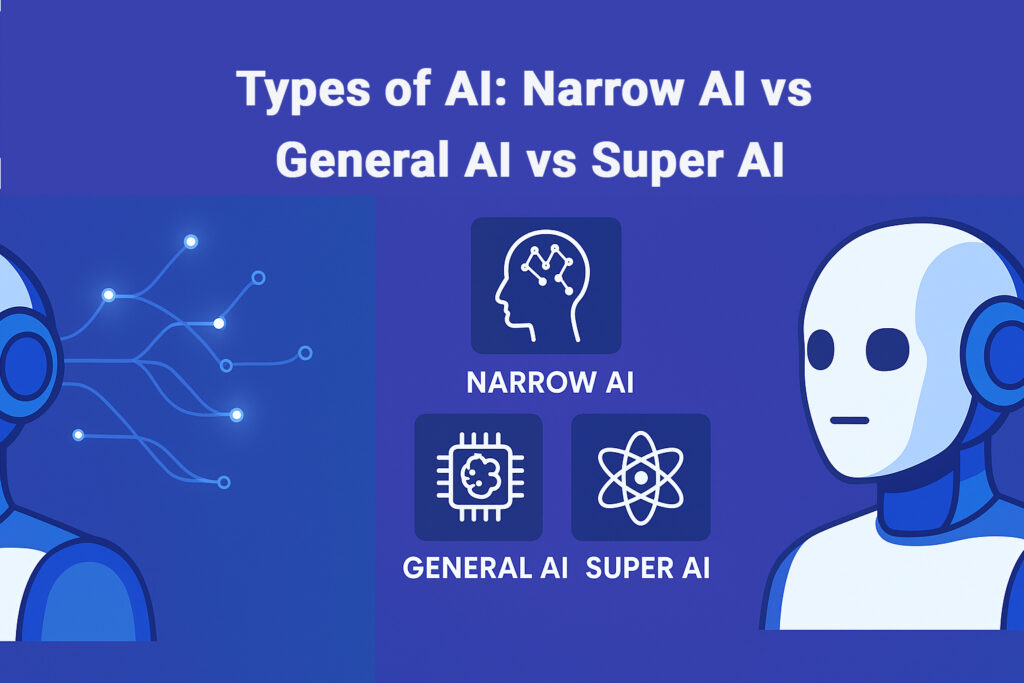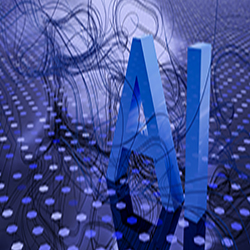Types of AI: Narrow AI, General AI, and Super AI

Introduction
Artificial Intelligence (AI) has become one of the most influential technologies of the 21st century. From powering virtual assistants to driving autonomous vehicles, AI is shaping the way we live, work, and interact. However, not all AI is the same. Researchers generally classify AI into three main categories: Narrow AI, General AI, and Super AI.
Each type has unique characteristics, capabilities, and implications for the future of technology and society. In this blog, we’ll explore the differences between these three types of AI, their real-world applications, and their potential to transform our world.
What Are the Types of AI?
Artificial Intelligence refers to machines designed to mimic human intelligence. But the level of intelligence and scope of ability varies. Based on capability, AI is usually divided into three categories:
- Narrow AI (Weak AI)
- General AI (Strong AI)
- Super AI (Artificial Superintelligence)
Narrow AI (Weak AI)
Definition
Narrow AI, also known as Weak AI, is the most common form of AI used today. It is designed to perform a specific task or a limited range of tasks. Unlike human intelligence, it cannot think beyond its programmed purpose.

Examples of Narrow AI
- Voice assistants like Siri, Alexa, Google Assistant
- Recommendation systems (Netflix, YouTube, Spotify)
- Spam filters for emails
- Customer support chatbots
- Facial recognition technology
Strengths
- Enhances daily life convenience
- Increases business productivity
- Performs repetitive tasks efficiently
Limitations
- Cannot think independently
- Restricted to pre-programmed tasks
- No self-awareness or creativity
* In short: Narrow AI is powerful in specific tasks but limited in scope.
General AI (Strong AI)
Definition
General AI, often called Strong AI, is a type of artificial intelligence that can perform any intellectual task that a human can do. It doesn’t just follow instructions—it can reason, learn, and adapt across different situations.
Potential Capabilities
- Problem-solving across multiple fields
- Independent decision-making
- Learning from experiences just like humans
- Understanding emotions and context
Current Status
At present, General AI does not exist. Scientists and researchers are still working on developing systems that can reach this level.
Why It Matters
If achieved, General AI could revolutionize industries like healthcare, education, and business. However, it also raises ethical and safety concerns, since machines would operate on a human-like level of intelligence.
Super AI (Artificial Superintelligence)
Definition
Super AI, or Artificial Superintelligence (ASI), is a hypothetical stage of AI where machines would surpass human intelligence in all aspects—creativity, reasoning, problem-solving, and even emotional intelligence.
Characteristics
- Faster and more accurate decision-making
- Superior problem-solving skills
- Ability to create new scientific theories or innovations
- Emotional understanding beyond human capability
Future Implications
- Could solve global challenges like climate change, poverty, and diseases
- Might bring risks such as loss of human control, unemployment, or ethical dilemmas
* In short: Super AI could either be humanity’s greatest achievement—or its biggest threat.
Future of AI Technology
The future of AI lies in the gradual transition from Narrow AI to General AI, and potentially to Super AI.
- Short-term: We will continue to see growth in Narrow AI applications, especially in automation, healthcare, and content creation.
- Mid-term: Research may bring breakthroughs in developing true General AI.
- Long-term: Super AI remains speculative but could reshape civilization itself.
AI’s future must balance innovation with ethics, ensuring that human values remain at the core of technological progress.
FAQs: Types of AI
1. What is the difference between Narrow AI and General AI?
Narrow AI is task-specific, while General AI can perform any intellectual task like a human.
2. Does General AI exist today?
No. General AI is still a theoretical concept, and researchers are working toward achieving it.
3. What are some examples of Super AI?
Super AI does not exist yet. It is a hypothetical stage where machines surpass human intelligence.
4. Is Super AI dangerous?
It could be, if not regulated properly. While it has potential to solve major problems, it also poses risks of losing human control.
5. Which type of AI is used in our daily lives?
We mostly use Narrow AI—voice assistants, chatbots, recommendation systems, and automation tools.
6. What is the future of AI technology?
The future will involve advancements in automation, AI-powered creativity, healthcare, and possibly breakthroughs toward General AI.
7. Can AI replace humans completely?
AI can replace repetitive tasks, but creativity, emotions, and ethical decisions remain uniquely human—for now.